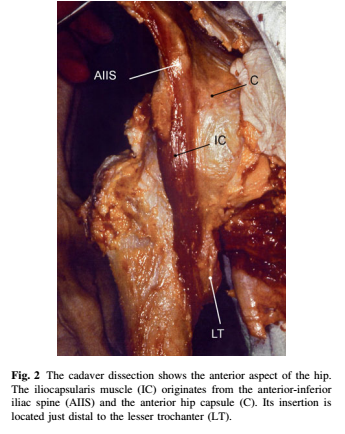The little known iliocapsularis
I bet I could needle that muscle....
As with many things, one thing often leads to another. I had a patient with anterior hip pain and what i believed was iliopsoas dysfunction, but I wanted to know EXACTLY which muscles attached to the hip capsule, to make sure I wasn’t missing anything.
I turned up some great info, including a nice .pdf lecture, which I am including the link to (1). That, along with this paper (2) began my journey.
 I had thought the iliopsoas attached to the hip capsule, but it turns out it doesn't, but the iliocapsularis does along with a host of others, including one of my favs, the gluteus minimus (3), which was believed to be part of the psoas, but actually is a completely separate muscle) . Did I mention that many of these are all FREE, FULL TEXT articles with links provided below?
I had thought the iliopsoas attached to the hip capsule, but it turns out it doesn't, but the iliocapsularis does along with a host of others, including one of my favs, the gluteus minimus (3), which was believed to be part of the psoas, but actually is a completely separate muscle) . Did I mention that many of these are all FREE, FULL TEXT articles with links provided below?
Anyway, I began reading, with great interest, about the iliocapsularis and I found yet another great review paper on it, along with mechanical hip pain (4). This last paper has some real clinical pearls and I recommend reading it the next opportunity you have a bit of time.
I began thinking about when the iliopsoas fires in the gait cycle (terminal stance to mid swing). So, it is firing eccentrically at pre swing (perhaps limiting or attenuating hip extension?), then concentrically through early and mid swing, when it becomes electrically silent. During running gait, the activation pattern is similar (5-7). This muscle is also implicated in femoroacetabular impingement (FAI), or more correctly anterior inferior iliac spine subspine impingement (AIIS Impingement) or iliopsoas impingement (IPI) (4). They all can cause anterior hip pain and they should all be considered in your differential.
The iliocapsularis muscle has its proximal attachment at the anterior-inferior iliac spine and the anterior hip capsule (3). It does not attach to the labrum (8). Its distal insertion is just distal to the lesser trochanter. It can sometimes inset into the iliofemoral ligament and/or the trochanteric line of the femur (9, 10). It is innervated by a branch of the femoral nerve (L2-4) (10). It is believed to act to raise the capsule of the hip and be an accessory stabilizer of the hip (3, 5, 8-10)
I started thinking about “Hmmm...How could I needle this?” This muscle will be hard to isolate from a muscle testing standpoint, but needling it it pretty easy, as long as you are careful and count your layers. Take a look at this link here.
So here is how you do it:
- have the patient lie supine an relaxed with a pillow beneath their knees
- find the iliopsoas tendon in the floor of the femoral triangle, just below and medial to the ASIS by palpating and having them gently contract to flex their thigh, but not moving it; you should be able to feel the hip flexors contract under your palpating hand. If you have the patient gently adduct the thigh, you can differentiate it from the pectineus, which is much more medial
- remember that iliacus lies anterior to the psoas and directly beneath the rectus femoris
- you will need to needle all the way to the femoral neck and back out to be sure you are there (I did not say this was going to be easy! See the diagram above for the layers as well as here: click here for anatomy picture.
OK, there you have it. the iliocapsularis. Another muscle you didn’t know you could access. It pays to know your anatomy!
Watch for a video in a future post on this guy. The story is not over...
Ivo
References :
1. https://www.mcjconsulting.com/meetings/2012/asm/ePosters/files/ISHA_Poster_202.pdf
2. http://pubs.rsna.org/doi/full/10.1148/radiol.12111320
3. Babst D1, Steppacher SD, Ganz R, Siebenrock KA, Tannast M. The iliocapsularis muscle: an important stabilizer in the dysplastic hip. Clin Orthop Relat Res. 2011 Jun;469(6):1728-34. doi: 10.1007/s11999-010-1705-x. Epub 2010 Dec 3.link to full text: http://www.ncbi.nlm.nih.gov/pmc/articles/PMC3094621/
4. Hammoud S1, Bedi A2, Voos JE3, Mauro CS4, Kelly BT1. The recognition and evaluation of patterns of compensatory injury in patients with mechanical hip pain. Sports Health. 2014 Mar;6(2):108-18. doi: 10.1177/1941738114522201. link to full text: http://www.ncbi.nlm.nih.gov/pmc/articles/PMC3931342/
5. Retchford TH1, Crossley KM, Grimaldi A, Kemp JL, Cowan SM Can local muscles augment stability in the hip? A narrative literature review. J Musculoskelet Neuronal Interact. 2013 Mar;13(1):1-12. link to full text: http://www.ismni.org/jmni/pdf/51/01RETCHFORD.pdf
6. Eva A. Andersson, Johnny Nilsson, Zhijia Ma, Alf Thorstensson Abdominal and hip flexor muscle activation during various training exercisesEuropean Journal of Applied Physiology and Occupational Physiology January 1997, Volume 75, Issue 2, pp 115-123 link to full text: http://link.springer.com/article/10.1007%2Fs004210050135#page-7. https://openarchive.ki.se/xmlui/handle/10616/43603
8. Anatomy of the iliocapsularis muscle. Relevance to surgery of the hip.Ward WT, Fleisch ID, Ganz R Clin Orthop Relat Res. 2000 May; (374):278-85.
9. HOLLINSHEAD W. H. (ed), Anatomy for surgeons: the back and limbs, vol. 3, Harper & Row, New York, 1969, 707.
10 SUJATHA D’COSTA, LAKSHMI A. RAMANATHAN, SAMPATH MADHYASTHA, S. R. NAYAK, LATHA V. PRABHU, RAJALAKSHMI RAI, VASUDHA V. SARALAYA, PRAKASH An accessory iliacus muscle: a case report Romanian Journal of Morphology and Embryology 2008, 49(3):407–409 link to full text : http://www.rjme.ro/RJME/resources/files/490308407409.pdf
Cover image credit: http://www.ncbi.nlm.nih.gov/pmc/articles/PMC3094621/#CR29
